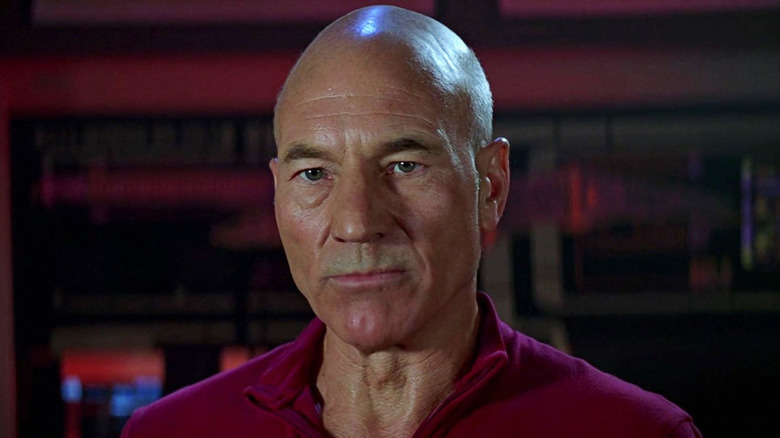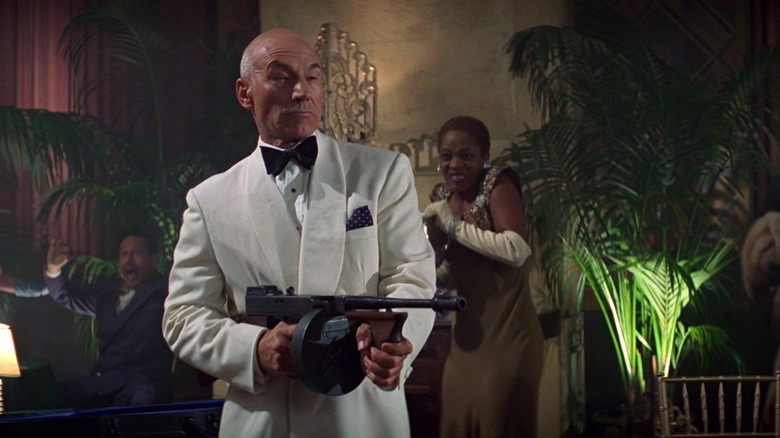Star Trek: First Contact Digitally Sliced Patrick Stewart Into Pieces For One Scene
In Jonathan Frakes' 1996 film "Star Trek: First Contact," the ordinarily diplomatic and level-headed Jean-Luc Picard (Patrick Stewart) inexplicably cracks. The Borg — an evil race of all-consuming cyborgs — have traveled back in time to the year 2063 to muck around with human history. They intend to stop a key moment of "Star Trek" history and assimilate as many people as they can into their unthinking mechanical collective. Several years before, Picard had been assimilated by the Borg, and was only rescued and extracted at the last minute.
Healing took a long time, but Picard faced the Borg on several occasions thereafter, and was finally able to confront them with control and thoughtfulness. In "First Contact," however, the Borg attack again, and Picard — for whatever reason — can't handle it this time. This time, when he sees a Borg, he shoots it. When he confronts the Borg Queen (Alice Krige), he breaks her spine. In one notable scene, two Borg infiltrate the holodeck and Picard constructs a 1930s-style noir mystery environment to distract them. Picard then grabs a holographic Tommy gun, flips off the holodeck's safety protocols, and blasts the Borgs with holographic bullets, killin' 'em good.
As he fires the gun, Picard screams like there's no tomorrow, his body vibrating with the ancient weapon's explosive kickback. For a few moments, he's essentially Rambo.
According to an oral history of "First Contact" printed in The Hollywood Reporter in 2016, a lot of that scene was achieved using digital effects. Stewart was on set actually holding a real prop Tommy gun, but the filmmakers didn't think his reactions were dramatic enough. Adam Howard, a visual effects supervisor on the film, revealed that he had to deconstruct and digitally recreate Stewart's body to give him the proper "jiggle."
Stewart's Tommy gun jiggle
Howard recalled that Frakes got two takes of Stewart firing the Tommy gun. In the first take, Stewart mimed a lot of kickback, flinched appropriately, and really provided a physical performance, wholly interacting with his gun. There were no blanks in the gun, so there were no on-set gunshots for Stewart to react to. In the second take, Stewart was steelier and more determined in his murders, leading him to move much less and look on without flinching. Howard doesn't comment on Stewart's performance in either take, but did say that the ultimate selection — the second — required a lot of extra effects work on his part:
"They chose the second take for us to work on to put the Tommy gun muzzle flashes into, but then they realized there wasn't enough kick in his arms or a real reaction in his body from the power of the gun. I literally cut his body apart digitally and I adjusted the kickback in his arms and added a very slight jiggle to the skin in his face and we put very slight blinks in his eyes so there were reactions to muzzle flashes going off in front of him."
Essentially, Howard got to do some of Stewart's acting for him.
The scene is brief, and the editing is so fast, a casual viewer might not recognize that Stewart's body was being digitally manipulated to shimmy and shake. Recall that "Star Trek" takes place in a world of phasers, which have no explosive "kick," and that bullets are considered obscure and old-fashioned; a 24th-century denizen wouldn't know guns. Picard, however, loves 1930s noir mysteries starring his favorite detective, Dixon Hill, so it stands to reason he, at least, would be familiar with Tommy guns.

